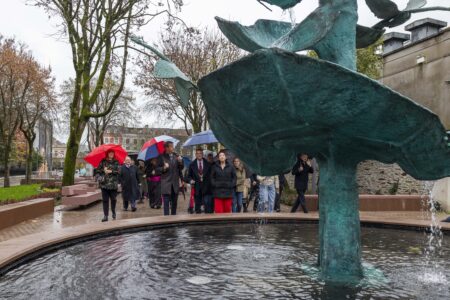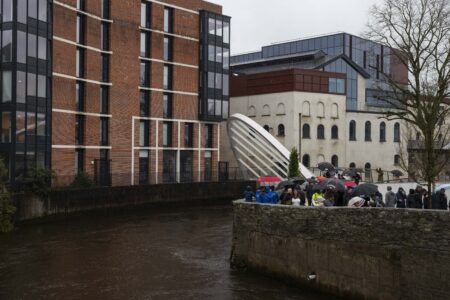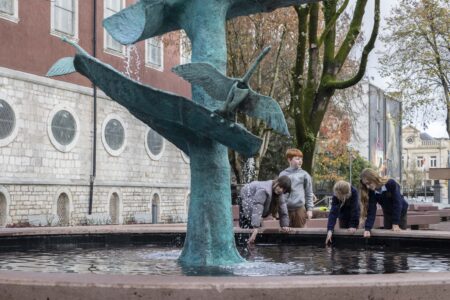14 November 2025
By Tom Collins
tom@TheCork.ie
The Lord Mayor of Cork City, Cllr Fergal Dennehy officially opened the redeveloped Bishop Lucey Park this afternoon – he then also opened a new pedestrian bridge at ‘Lambley’s Lane’ on the former Beamish & Crawford Brewery site
The 1980’s park boundary walls and fencing are removed to open up the space, allowing greater physical and visual connection between the park and surrounding streets. The city’s medieval walls, which run through the site, are now a focal point, and the redesign features a new pavilion and plaza, and new tower structure marking the eastern entrance on South Main Street.
The 13th century city wall is a significant heritage landmark, uncovered during excavations in 1984. As part of the park’s later redevelopment, an additional section of the city wall was exposed, enhancing its presence as a defining feature. Today, the city wall forms a striking an continuous element that clearly marks the park’s eastern boundary.
Great care was taken to preserve and sensitively restore several heritage and public art features within the Park, including the Christchurch graveyard, Seamus Murphy’s “The Onion Seller” sculpture, John Behan’s “The Swan Fountain” and the Boxer’s Wall.
The Park’s design, by Hall McKnight Architects, was chosen following an international architectural and landscape design competition run by the Royal Institute of Architects of Ireland in conjunction with Cork City Council and construction, carried out by Cumnor Construction, was funded under the Urban Regeneration and Development Fund (URDF).

Lord Mayor of Cork Cllr. Fergal Dennehy opened today in the rain the reimagined Bishop Lucey Park and new pedestrian and cycle bridge at Lambley, Cork City. .
Picture: Clare Keogh

Lord Mayor of Cork Cllr. Fergal Dennehy opened today in the rain the new pedestrian and cycle bridge at Lambley, Cork City
Picture: Clare Keogh
The Lord Mayor also opened the new pedestrian and cycle bridge that connects Lambley’s Lane (off South Main Street) to Wandesford Quay. The new 27 metre steel span bridge was designed by Seán Harrington Architects of Arup design team, and manufactured by Thompsons of Carlow, who also manufactured Mary Elmes Bridge. It provides a direct pedestrian and cycle connection from Parnell Place to Wandesford Quay, via Oliver Plunkett Street and Tuckey Street. The bridge was co-funded by URDF and the National Transport Authority.
The Lord Mayor said: “It’s fantastic to be able to give this wonderful amenity space back to the public in time for Christmas. The redeveloped Park is a fusion of the City’s medieval heritage and modern, functional design, opened up to the wider city centre. It will be a place of relaxation, play, performance and community gathering. It will attract more people to enjoy this green space in the heart of the city.”
Chief Executive of Cork City Council Valerie O’Sullivan said: “The City Council’s ambition was always to deliver a high-quality facility for the city, and that has been done. Because the city of Cork deserves no less. The City Council also wanted to ensure that after two years of work and disruption, that the park would be available to the public in time for Christmas.”
She added: “The opening of the park and the new bridge, combined with the public realm upgrades in and around South Main Street, marks a significant milestone in the transformation of this historic area that will enhance connectivity, encourage footfall, and foster a stronger sense of community, delivering long-term benefits for residents, businesses, and visitors.”
The redevelopment of Bishop Lucey Park is a key part of Cork City Council’s City Centre Strategy and integral to improving the quality of amenities in a city that is projected to grow to 300,000 in the next 20 years – with an increasing number of young families expected to live in the city centre.
Works are ongoing on the wider Beamish & Crawford Public Realm Upgrade Scheme which, when completed, will see a complete renewal of the area around the southern gateway to the medieval city, connecting the Grand Parade and a series of historic lanes, streets and Bishop Lucey Park with the south channel of the River Lee and the city centre business core. The entire scheme is expected to be completed in early summer 2026.
History of the Park
The site of Bishop Lucey Park had previously been occupied by shops and residential buildings until a large fire in 1970 destroyed the Sean Jennings furniture store which was located at the corner of Grand Parade and Tuckey Street. In 1985 this public park was opened in celebration of the 800th anniversary of Cork being granted its charter.
The Archway
The archway that stands at the Grand Parade entrance once stood at the entrance to the Corn Exchange on Anglesea Street. It was cleaned and restored as part of the works in the Park.
The Onion Seller
The bronze sculpture ‘The Onion Seller (Mary Anne)’ by Seamus Murphy commemorates the traders of Cornmarket Street. The onion sellers, also known as ‘Shawlies’, were part of an old Cork custom. For several centuries working-class Irish women made a living as street traders selling fruit, vegetables and second-hand clothing.
The Swan Fountain
The Swan Fountain’ by Irish artist John Behan was commissioned by the city to commemorate Cork’s 800 years as a chartered city. Each swan represents 100 years.
The Boxer’s Wall
The boxer’s wall can be found at the southern side of the park. This wall acknowledges the many great achievements of members of the boxing community in Cork since the first plaque was erected in 1987, honouring World Champion Jack McAuliffe.
Pedestrian Bridge
The new bridge provides a direct pedestrian and cycling link between the city centre from the bus station at Parnell Place to Wandesford Quay onward to the west of the city, via Oliver Plunkett Street and Tuckey Street. It is hoped to hold a public vote to name this new bridge upon completion of the Beamish & Crawford Public Realm Improvement Scheme, similar to that held to name Mary Elmes Bridge and Vernon Mount Bridge.




